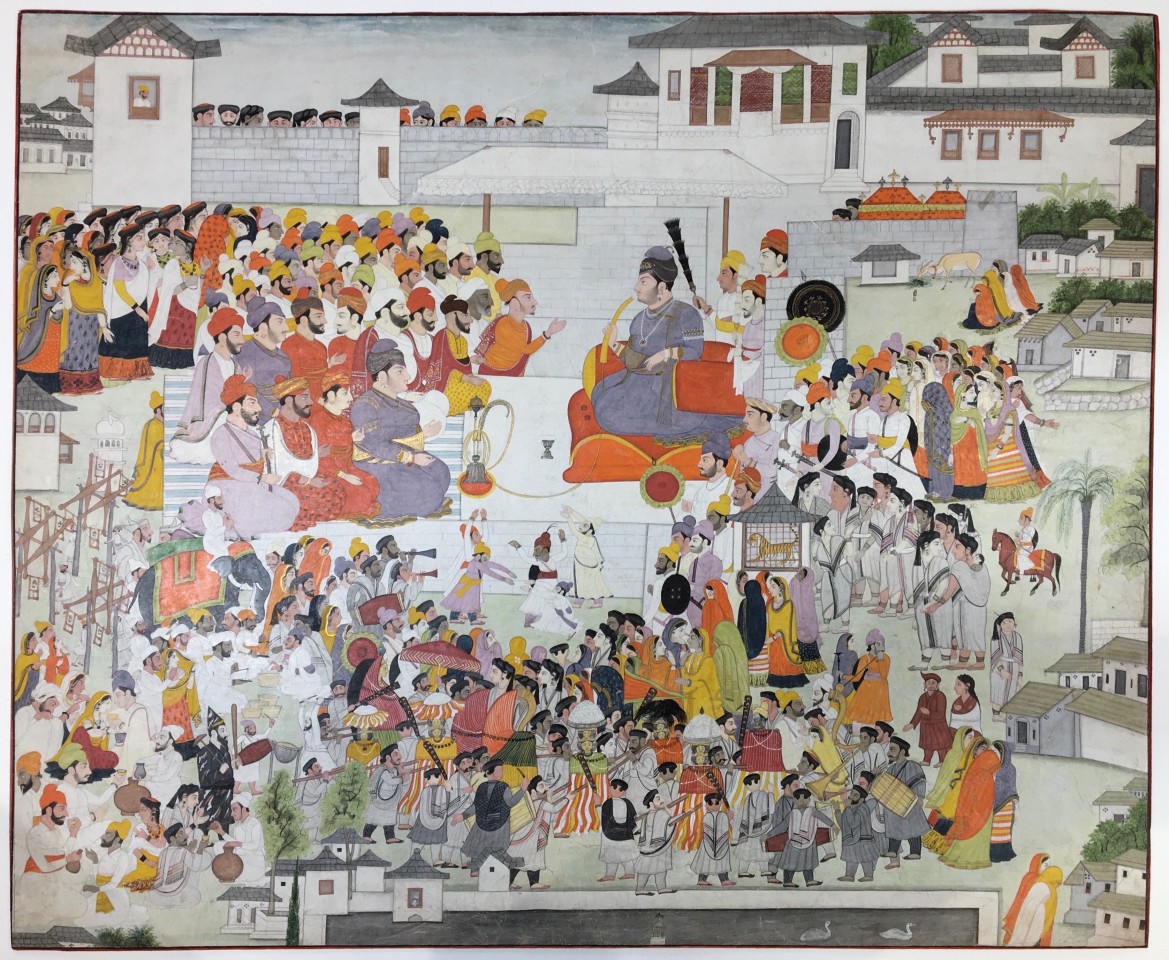Folio 46.5 x 56.5 cm.
Opaque Pigment on paper
Mandi, India
1807
Inscribed on the reverse:
sri vikramaditya samvat 1864 sastra samvata 83 re falgun pra[vishte] 15 sri shivaratri ri yatra ra chitra sri maharaje ishwari sena di agya te chitrakar sajanu daroga upadhyay janaki das
[On the] day 15 of the month of Falgun (March-April) of 1807, the painting of the Shivaratri procession was made by artist Sajnu on the orders of Maharaja Ishwari Sen [and submitted to] Daroga Upadhyay Janaki Das
This rare and important painting is one of the few large format works created at the court of Mandi where an artist is identified by inscription. In this instance the inscriptions identifies the painter as the famous Pahari artist Sajnu. The painting is an elaborate festival scene, which highlights the artist’s skill at working on court and crowd scenes. Such elaborate processional scenes of this scale are rare and the inscription identifying the event, the details of the commission, and the artist makes it all the more important.
In many ways the current painting is a partner painting to the Court Scene depicting the Janmashtami celebrations of Raja Ishwari Sen that was exhibited at Asian Art in London in 2018, which also identified the artist Sajnu as the creator of the work. Here rather than the formal confines of the court, Maharaja Ishwari Sen is seen celebrating the Shivaratri festival with his courtiers and the entire local populace. The Mandi festival remains famous today as it transforms Mandi town into a venue for grand celebrations, where all the Gods and Goddesses, said to number more than two hundred deities assemble in the town. The festival opens on the day of Shivaratri.
Mandi town located on the banks of the Beas River is one of the oldest towns of Himachal Pradesh with over eighty temples dedicated to different gods and goddesses dotted around its periphery. There are several legends linked to the celebration of this event. The festival is centred on the protector deity of Mandi ‘Mado Rai’ (Lord Vishnu) and Lord Shiva of the Bhootnath temple of Mandi. Raja Suraj Sen (1664 to 1679), who did not have an heir, built the temple known as ‘Madhav Rai temple, dedicated to a form of Lord Vishnu, as the protector of Mandi. An elegant silver image of Radha and Krishna was made by his goldsmith Bhima, in the year 1705, which was named "Madho Rai" and deified, and crowned as the King of the State of Mandi. Since then the rulers served the state as servants of Madho Rai and custodians of the State. To this day Suraj Sen’s successors have held the deity in great reverence. This god is represented with precedence over all other gods on various religious occasions. However, the specific observance of this festival as a fair, starting with Shivaratri, is linked to its ruler Ishwari Sen. Ishwari Sen was held as a prisoner at the neighboring court of Kangra for twelve years, after he lost his kingdom in the war waged by Sansar Chand of Punjab, in 1792. He was finally released by the Gurkhas who invaded Kangra and Mandi. Afterwards, when the Gurkhas had restored the Mandi state to Ishwari Sen, he was given a reception on his return to Mandi, his state capital. On this occasion, the King invited all the local deities of the Kingdom and held a grand celebration, and this day fell on the opening day of the Shivaratri festival. Every year since then the Mandi fair has taken place during Shivaratri .
This painting in conjunction with the court scene provides an important historical insight into the workings of the court of Mandi, shortly after the return of its ruler Ishwari Sen from imprisonment at Kangra. The Court Scene identifies by individual inscriptions the main figures at court, and these figures reappear in the current work, but without inscription. The pair of paintings supports the view that Ishwari Sen brought the artist Sajnu with him from Kangra and immediately began commissioning large format paintings in the Kangra style at his own court. The following years proved to be a great late blossoming of the arts at the Mandi court atelier, and these previously unpublished works are key examples from the period.
